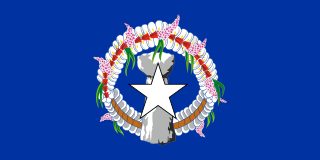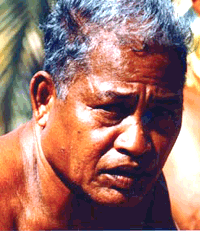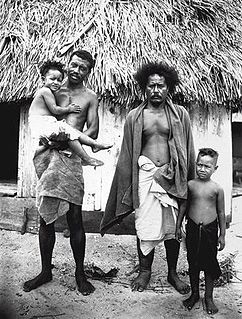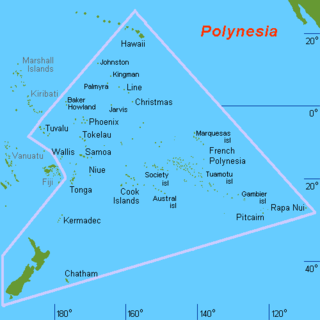Related Research Articles

Micronesia is a subregion of Oceania, composed of thousands of small islands in the western Pacific Ocean. It has a close shared cultural history with three other island regions: the Philippines to the west, Polynesia to the east, and Melanesia to the south; as well as with the wider Austronesian peoples.

The Northern Mariana Islands, officially the Commonwealth of the Northern Mariana Islands, is an insular area and commonwealth of the United States consisting of 14 islands in the northwestern Pacific Ocean. The CNMI includes the 14 northernmost islands in the Mariana Archipelago; the southernmost island, Guam, is a separate U.S. territory. The CNMI and Guam are the westernmost territories of the United States.

The Caroline Islands are a widely scattered archipelago of tiny islands in the western Pacific Ocean, to the north of New Guinea. Politically they are divided between the Federated States of Micronesia in the eastern part of the group, and Palau at the extreme western end. Historically, this area was also called Nuevas Filipinas or New Philippines as they were part of the Spanish East Indies and governed from Manila in the Philippines.

The Polynesian Voyaging Society (PVS) is a non-profit research and educational corporation based in Honolulu, Hawaiʻi. PVS was established to research and perpetuate traditional Polynesian voyaging methods. Using replicas of traditional double-hulled canoes, PVS undertakes voyages throughout Polynesia navigating without modern instruments.
Carolinian is an Austronesian language originating in the Caroline Islands, but spoken in the Northern Mariana Islands. It is an official language of the Carolinian people. Carolinian is a threatened language according to the Catalogue of Endangered Languages (ELCat), but available data is scarce. There are approximately 3,100 native speakers in the world. Carolinian has 95% lexical similarity with Satawalese, 88% with Woleaian and Puluwatese; 81% with Mortlockese; 78% with Chuukese, 74% with Ulithian.

Hōkūleʻa is a performance-accurate waʻa kaulua, a Polynesian double-hulled voyaging canoe. Launched on 8 March 1975 by the Polynesian Voyaging Society, she is best known for her 1976 Hawaiʻi to Tahiti voyage completed with exclusively Polynesian navigation techniques The primary goal of the voyage was to explore the anthropological theory of the Asiatic origin of native Oceanic people, of Polynesians and Hawaiians in particular, as the result of purposeful trips through the Pacific, as opposed to passive drifting on currents, or sailing from the Americas. A secondary project goal was to have the canoe and voyage "serve as vehicles for the cultural revitalization of Hawaiians and other Polynesians".

The Hawaiian Renaissance was the Hawaiian resurgence of a distinct cultural identity that draws upon traditional kānaka maoli culture, with a significant divergence from the tourism-based culture which Hawaiʻi was previously known for worldwide. The Hawaiian Renaissance has been pointed to as a global model for biocultural restoration and sustainability.

Pius "Mau" Piailug was a Micronesian navigator from the Carolinian island of Satawal, best known as a teacher of traditional, non-instrument wayfinding methods for open-ocean voyaging. Mau's Carolinian navigation system, which relies on navigational clues using the Sun and stars, winds and clouds, seas and swells, and birds and fish, was acquired through rote learning passed down through teachings in the oral tradition. He earned the title of master navigator (palu) by the age of eighteen, around the time the first American missionaries arrived in Satawal. As he neared middle age, Mau grew concerned that the practice of navigation in Satawal would disappear as his people became acculturated to Western values. In the hope that the navigational tradition would be preserved for future generations, Mau shared his knowledge with the Polynesian Voyaging Society (PVS). With Mau's help, PVS used experimental archaeology to recreate and test lost Hawaiian navigational techniques on the Hōkūle‘a, a modern reconstruction of a double-hulled Hawaiian voyaging canoe.

Stick charts were made and used by the Marshallese to navigate the Pacific Ocean by canoe off the coast of the Marshall Islands. The charts represented major ocean swell patterns and the ways the islands disrupted those patterns, typically determined by sensing disruptions in ocean swells by islands during sea navigation. Most stick charts were made from the midribs of coconut fronds that were tied together to form an open framework. Island locations were represented by shells tied to the framework, or by the lashed junction of two or more sticks. The threads represented prevailing ocean surface wave-crests and directions they took as they approached islands and met other similar wave-crests formed by the ebb and flow of breakers. Individual charts varied so much in form and interpretation that the individual navigator who made the chart was the only person who could fully interpret and use it. The use of stick charts ended after World War II when new electronic technologies made navigation more accessible and travel among islands by canoe lessened.
David Henry Lewis was a sailor, adventurer, doctor, and Polynesian scholar. He is best known for his studies on the traditional systems of navigation used by the Pacific Islanders. His studies, published in the book We, the Navigators, made these navigational methods known to a wide audience and helped to inspire a revival of traditional voyaging methods in the South Pacific.
Pwo is a sacred initiation ritual, in which students of traditional navigation in the Caroline Islands in Micronesia become navigators (palu) and are initiated in the associated secrets. Many islanders in the area indicate that this ceremony originated on the island of Pollap, or nearby islands.
Weriyeng is one of the last two schools of traditional navigation found in the central Caroline Islands in Micronesia, the other being Fanur. By tradition these two schools were considered to be the most high of all the schools of navigation that once dotted the islands of the central Carolines. By tradition the Weriyeng school was founded on the island of Pulap, which is today in the Pattiw region of Chuuk State, Federated States of Micronesia.
Alingano Maisu, also known as Maisu, is a double-hulled voyaging canoe built in Kawaihae, Hawaii by members of Na Kalai Waʻa Moku o Hawaiʻi and ʻOhana Wa'a members from throughout the Pacific and abroad as a gift and tribute to Satawalese navigator Mau Piailug, who navigated the voyaging canoe Hōkūleʻa on her maiden voyage to Tahiti in 1976 and has since trained numerous native Hawaiians in the ancient art of wayfinding. The word maisu comes from the Satawalese word for breadfruit that has been knocked down by storm winds and is therefore available for anyone to take. The name is said to symbolize the knowledge of navigation that is made freely available.

Traditional Polynesian navigation was used for thousands of years to make long voyages across thousands of kilometres of the open Pacific Ocean. Navigators travelled to small inhabited islands using wayfinding techniques and knowledge passed by oral tradition from master to apprentice, often in the form of song. Generally, each island maintained a guild of navigators who had very high status; in times of famine or difficulty, they could trade for aid or evacuate people to neighbouring islands. As of 2014, these traditional navigation methods are still taught in the Polynesian outlier of Taumako in the Solomons.

Carolinians are an Austronesian ethnic group who originated in Oceania, in the Caroline Islands, with a total population of around 8,500 people. They are also known as Remathau in the Yap's outer islands. The Carolinian word means "People of the Deep Sea." It is thought that their ancestors may have originally immigrated from Asia and Indonesia to Micronesia around 2,000 years ago. Their primary language is Carolinian, called Refaluwasch by native speakers, which has a total of about 5,700 speakers. The Carolinians have a matriarchal society in which respect is a very important factor in their daily lives, especially toward the matriarchs. Most Carolinians are of the Roman Catholic faith.

Polynesia is a subregion of Oceania, made up of more than 1,000 islands scattered over the central and southern Pacific Ocean. The indigenous people who inhabit the islands of Polynesia are termed Polynesians, sharing many similar traits including language family, culture, and beliefs. Historically, they had a strong tradition of sailing and using stars to navigate at night. The largest country in Polynesia is New Zealand.

Wa are traditional sailing outrigger canoes of the Caroline Islands. They have a single outrigger. They are similar to the sakman of the Northern Marianas.
Namonabetiu is a group of atolls within the Federated States of Micronesia; it comprises Puluwat, Pulap, Tamatam, and Pulusuk.
We, the Navigators, The Ancient Art of Landfinding in the Pacific is a 1972 book by the British-born New Zealand doctor David Lewis, which explains the principles of Micronesian and Polynesian navigation through his experience of placing his boat under control of several traditional navigators on long ocean voyages.
etak is a word of Micronesian origin for a distinctive cognitive and mnemonic approach to oceanic navigation and orientation involving a notional reference point or "island", called etak, and triangulation based on it. The system under that name was found in the Caroline Islands, and the literal meaning of etak is "refuge". Alfred Gell described it as a way of encoding dead reckoning applied to sea journeys. It is an example of a dynamic cognitive map.
References
- ↑ Gladwin, Thomas (1970). East Is a Big Bird; Navigation & Logic on Puluwat Atoll. Cambridge Massachusetts: Harvard University Press. ISBN 0-674-22425-6.
- ↑ Michael McCoy (1973). "A Renaissance in Carolinian-Marianas Voyaging". Journal of the Polynesian Society, Auckland University.
Then, in 1969, David Lewis visited the Central Carolinian island of Puluwat in his auxiliary ketch, the Isbjorn, while investigating ongoing systems of navigation throughout Oceania. Lewis had heard that the navigators of Puluwat possessed the knowledge to sail the 900-mile round-trip to Saipan, and upon arrival there asked one of the navigators, Hipour, to accompany him on the Isbjorn and navigate the vessel to Saipan and return. It was understood that only the indigenous knowledge that had been taught Hipour by the navigators of Puluwat would be used. The successful completion of this voyage, plus other factors, has led to a renaissance in Carolinian-Marianas voyaging and strengthened ties between Carolinians and their cousins on Saipan.



